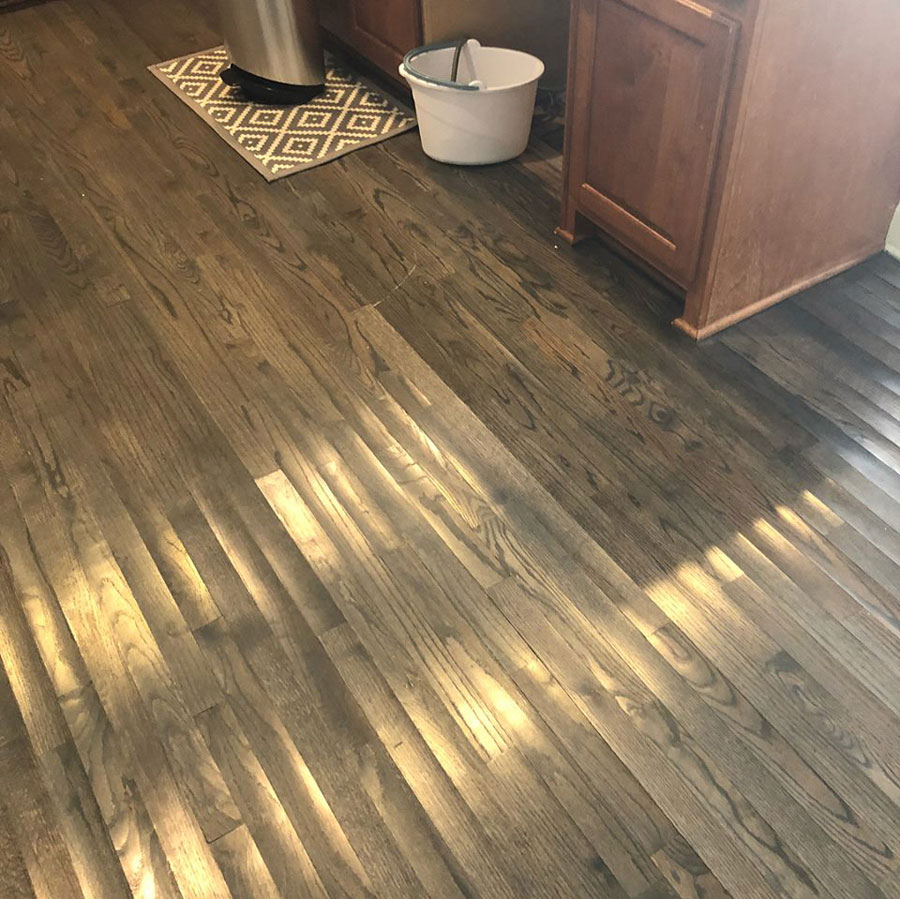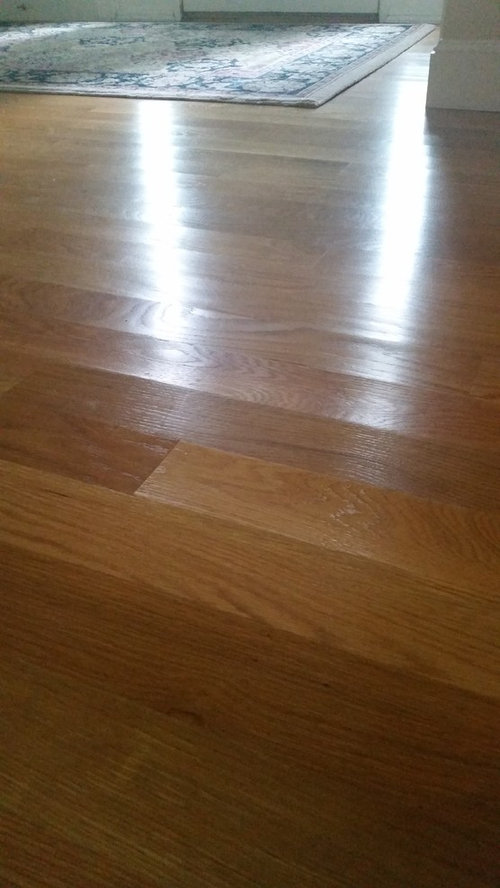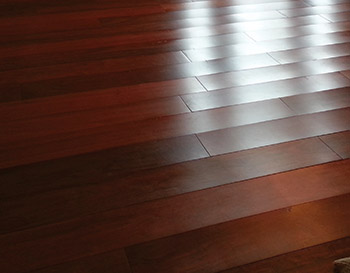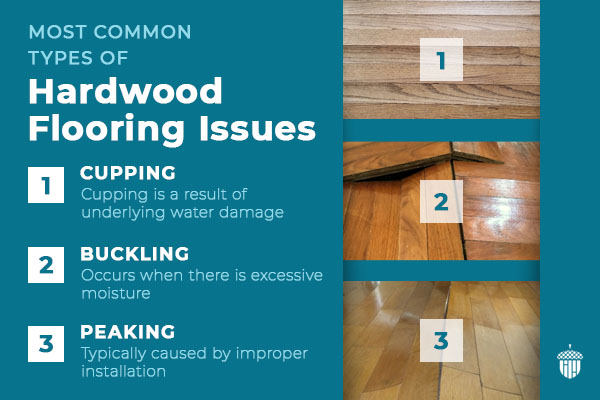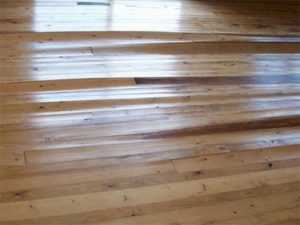Hardwood Floor Cupping: What Is It?
Hardwood floor cupping is a common problem when hardwood floorboards develop a concave or “cup” shape, with the edges of the boards raised higher than the center. This can create an uneven surface and detract from the appearance and functionality of the floor. Understanding what causes hardwood floor cupping is essential for effectively preventing and addressing this issue. Here’s what you need to know about hardwood floor cupping:
- Definition: Hardwood floor cupping occurs when moisture imbalance causes the wood fibers on the underside of the floorboards to expand more than the upper surface, resulting in a cupped or raised appearance. This imbalance in moisture content causes the boards to warp and deform, leading to the characteristic cupping effect.
- Appearance: Cupped hardwood floors typically exhibit a concave or dished shape, with the edges of the boards raised higher than the center. This can create noticeable gaps between the boards and an uneven surface that may pose tripping hazards. In severe cases, cupping can cause the floorboards to buckle or lift away from the subfloor, requiring extensive repairs or replacement.
- Causes: Hardwood floor cupping is primarily caused by moisture infiltration into the wood, which disrupts the natural equilibrium of moisture content within the boards. Common sources of moisture include water leaks, high humidity levels, improper installation techniques, and inadequate subfloor ventilation. Identifying and addressing the underlying cause of moisture intrusion is essential for preventing cupping and preserving the integrity of the hardwood floor.
- Effects: In addition to affecting the hardwood floor’s appearance, cupping can compromise its structural integrity and longevity. Cupped floorboards are more susceptible to damage from foot traffic, furniture weight, and environmental factors, increasing the risk of cracks, splits, and splinters. Cupping can also exacerbate moisture-related issues such as mold and mildew growth, further compromising indoor air quality and occupant health.
- Prevention and Treatment: Preventing hardwood floor cupping involves maintaining proper moisture levels in the indoor environment and implementing effective moisture control measures. This may include using dehumidifiers to reduce humidity levels, installing vapor barriers or moisture barriers beneath the hardwood flooring, and ensuring proper subfloor ventilation. In cases where cupping has already occurred, remedial measures such as sanding, refinishing, or replacing affected floorboards may be necessary to restore the floor’s appearance and functionality.

Moisture as the Primary Culprit: How Water Causes Cupping
Moisture is the primary culprit behind hardwood floor cupping, as it disrupts the natural equilibrium of moisture content within the wood and causes the floorboards to warp and deform. Understanding how water infiltrates hardwood floors and contributes to cupping is essential for preventing and addressing this common flooring issue. Here’s how water causes hardwood floor cupping:
Excessive Moisture Absorption: Hardwood floors are naturally porous and absorbent, allowing them to expand and contract with changes in humidity levels. However, when exposed to excessive moisture, such as from water leaks, spills, or high humidity levels, the wood fibers within the floorboards can absorb more moisture than they can release, leading to swelling and cupping.
Uneven Moisture Distribution: Moisture infiltration into hardwood floors is often uneven, with certain areas of the floor experiencing higher levels of moisture than others. This uneven moisture distribution can create localized swelling and cupping in specific areas of the floor, resulting in uneven surface and aesthetic defects.
Delayed Effects: Hardwood floor cupping may not become apparent immediately after water exposure, as it can take time for the moisture to penetrate the wood and cause the fibers to swell and deform. In some cases, cupping may develop gradually over days, weeks, or even months following a water-related incident, making it important to monitor the floor for signs of cupping and address any moisture issues promptly.
Persistent Moisture Sources: Persistent sources of moisture, such as water leaks from plumbing fixtures, appliances, or structural defects, can exacerbate hardwood floor cupping and lead to ongoing moisture-related problems. Even minor leaks or condensation buildup can contribute to cupping if left unaddressed, highlighting the importance of identifying and repairing moisture sources to prevent further damage to the hardwood floor.
Environmental Factors: Environmental factors such as high humidity levels, temperature fluctuations, and poor ventilation can also contribute to hardwood floor cupping by creating conditions conducive to moisture infiltration and retention. Improving indoor air circulation, using dehumidifiers to reduce humidity levels, and sealing gaps and cracks in the building envelope can help mitigate these environmental factors and prevent cupping.
Preventive Measures: Preventing hardwood floor cupping involves addressing the underlying causes of moisture infiltration and implementing effective moisture control measures. This may include repairing water leaks, maintaining proper indoor humidity levels, using moisture-resistant flooring materials, and sealing and waterproofing the subfloor to prevent moisture intrusion from below.
Subfloor Moisture: The Hidden Enemy of Hardwood Floors
Subfloor moisture is a hidden enemy that can wreak havoc on hardwood floors, leading to cupping, warping, and structural damage. Understanding how subfloor moisture affects hardwood floors is essential for effectively preventing and addressing moisture-related issues. Here’s what you need to know about subfloor moisture and its impact on hardwood floors:
Definition: Subfloor moisture refers to moisture present beneath the surface of the subfloor, either from groundwater intrusion, moisture vapor transmission, or plumbing leaks. When subfloor moisture levels are excessive, moisture can migrate upward through the subfloor and into the hardwood flooring above, leading to swelling, cupping, and other moisture-related problems.
Sources of Subfloor Moisture: Subfloor moisture can originate from various sources, including groundwater infiltration through foundation cracks or porous concrete, moisture vapor transmission from the soil beneath the building, and plumbing leaks or water spills that penetrate the subfloor material. Identifying the source of subfloor moisture is essential for determining the appropriate remedial measures to prevent further damage to the hardwood floor.
Effects on Hardwood Floors: Excessive subfloor moisture can have detrimental effects on hardwood floors, including cupping, warping, buckling, mold, and mildew growth. As moisture migrates upward through the subfloor, it can cause the wood fibers within the hardwood floorboards to swell and deform, resulting in the characteristic cupped appearance. In severe cases, subfloor moisture can compromise the structural integrity of the hardwood floor and require extensive repairs or replacement.
Moisture Testing: Moisture testing is a critical step in assessing subfloor moisture levels and determining the risk of moisture-related issues in hardwood floors. Various moisture testing methods, such as moisture meters, calcium chloride tests, and relative humidity tests, can be used to measure moisture levels in the subfloor and determine if additional moisture control measures are needed to prevent cupping and other moisture-related problems.
Preventive Measures: Preventing subfloor moisture infiltration is essential for preserving the integrity and longevity of hardwood floors. This may include installing vapor barriers or moisture barriers beneath the hardwood flooring to prevent moisture migration from the subfloor, improving drainage around the foundation to prevent groundwater infiltration, and maintaining proper ventilation and humidity levels in the indoor environment to prevent condensation and moisture buildup.
Remedial Measures: In cases where subfloor moisture has already caused damage to hardwood floors, remedial measures may be necessary to address cupping, warping, or other moisture-related issues. This may involve sanding and refinishing the affected floorboards to restore their appearance and functionality, replacing damaged floorboards with new ones, or installing moisture-resistant flooring materials in areas prone to moisture infiltration.
Environmental Factors: Humidity and Temperature
Environmental factors such as humidity and temperature play a significant role in the development of hardwood floor cupping, as they can create conditions conducive to moisture infiltration and retention. Understanding how humidity and temperature affect hardwood floors is essential for effectively preventing and addressing moisture-related issues. Here’s what you need to know about the environmental factors that contribute to hardwood floor cupping:
Humidity Levels: Humidity refers to the amount of moisture present in the air, and high humidity levels can increase the risk of hardwood floor cupping by providing ample moisture for the wood fibers to absorb and swell. In areas with high humidity, such as bathrooms, kitchens, and basements, hardwood floors are particularly susceptible to cupping and other moisture-related problems. Monitoring indoor humidity levels and using dehumidifiers to maintain optimal humidity levels can help prevent cupping and protect hardwood floors from damage.
Temperature Fluctuations: Temperature fluctuations can also affect hardwood floors by causing the wood to expand and contract as it absorbs and releases moisture. Rapid changes in temperature, such as from heating or cooling systems, direct sunlight, or seasonal weather patterns, can exacerbate moisture-related issues and lead to cupping, warping, and structural damage. Maintaining a stable indoor temperature and minimizing exposure to direct sunlight can help mitigate temperature-related effects on hardwood floors.
Seasonal Variations: Seasonal variations in humidity and temperature can have a significant impact on hardwood floors, as changes in weather patterns can cause fluctuations in moisture levels and temperature throughout the year. During the summer months, when humidity levels are typically higher, hardwood floors may be more prone to cupping and swelling. Conversely, during the winter months, when humidity levels are lower, hardwood floors may be more susceptible to shrinking and gaps between floorboards. Implementing seasonal maintenance routines, such as adjusting humidity levels with humidifiers or dehumidifiers, can help minimize the effects of seasonal variations on hardwood floors.
Relative Humidity: Relative humidity is a measure of the moisture content in the air relative to the air’s maximum moisture-holding capacity at a given temperature. High relative humidity levels can increase the risk of hardwood floor cupping by providing excess moisture for the wood fibers to absorb and swell. Monitoring indoor relative humidity levels and maintaining them within the optimal range of 30% to 50% can help prevent cupping and ensure the long-term durability and stability of hardwood floors.
Condensation: Condensation occurs when warm, moist air comes into contact with a cool surface, causing the moisture in the air to condense into water droplets. Condensation can occur on hardwood floors in areas with high humidity levels or poor ventilation, such as bathrooms, kitchens, and laundry rooms, and can contribute to cupping and other moisture-related problems. Improving ventilation, using exhaust fans, and sealing gaps and cracks in the building envelope can help prevent condensation and minimize its effects on hardwood floors.
Preventive Measures and Solutions for Hardwood Floor Cupping
Preventing hardwood floor cupping involves implementing effective moisture control measures and addressing underlying issues that contribute to moisture infiltration and retention. By taking proactive steps to control humidity levels, improve ventilation, and maintain proper subfloor conditions, homeowners and building occupants can protect their hardwood floors from cupping and other moisture-related problems. Here are some preventive measures and solutions for hardwood floor cupping:
Maintain Optimal Indoor Humidity Levels: Monitoring and controlling indoor humidity levels is essential for preventing hardwood floor cupping. Use a hygrometer to measure humidity levels in the home and ensure they remain within the optimal range of 30% to 50%. Use humidifiers to add moisture to the air during dry winter months and dehumidifiers to remove excess moisture during humid summer months.
Improve Ventilation: Proper ventilation is essential for maintaining healthy indoor air quality and preventing moisture buildup in the home. Ensure that bathrooms, kitchens, and other high-moisture areas are adequately ventilated with exhaust fans or windows to remove excess moisture and prevent condensation buildup on hardwood floors.
Address Water Leaks and Plumbing Issues: Water leaks from plumbing fixtures, appliances, or structural defects can contribute to hardwood floor cupping by introducing excess moisture into the subfloor and flooring materials. Inspect plumbing systems regularly for leaks, repair any leaks promptly, and address any water damage to prevent further moisture-related problems.
Install Vapor Barriers or Moisture Barriers: Installing vapor barriers or moisture barriers beneath hardwood flooring can help prevent moisture migration from the subfloor and reduce the risk of cupping and other moisture-related issues. Vapor barriers are typically installed between the subfloor and hardwood flooring to block moisture vapor transmission and create a barrier against moisture infiltration.
Use Engineered Hardwood Flooring: Engineered hardwood flooring is less susceptible to moisture-related issues such as cupping and warping than solid hardwood flooring, making it a practical choice for high-moisture areas such as basements, kitchens, and bathrooms. Engineered hardwood flooring consists of multiple layers of wood veneer bonded together with adhesive and is more stable and resistant to moisture than solid hardwood flooring.
Monitor Subfloor Conditions: Regularly inspecting and monitoring subfloor conditions is essential for identifying potential sources of moisture infiltration and addressing them before they lead to hardwood floor cupping. Use moisture meters or moisture testing kits to measure subfloor moisture levels and identify areas of concern that may require remedial action.
Implement Preventive Maintenance Routines: Implementing preventive maintenance routines can help minimize the risk of hardwood floor cupping and prolong the life of the flooring material. This may include sanding and refinishing the hardwood floors periodically to remove surface imperfections and restore their appearance, inspecting and repairing any damaged floorboards or finishes, and sealing gaps and cracks in the floor to prevent moisture intrusion.
cupped hardwood floors
Wood Floor Cupping: Why Does it Happen?
Avoid Cupping and Buckling in Hardwood Floors – Twenty u0026 Oak
Why Are My Hardwood Floors Cupping? – Crawl Space Brothers
Summer Related Hardwood Floor Problems and Fixes – City Floor
Floor Cupping – Foundation Waterproofing 101.
Related Posts:
- Hardwood Flooring Rustic Look
- Using Hardwood Flooring For Stairs
- Hardwood Floor Stain Removal Tips
- Hardwood Floor Installation Cost Vancouver
- Vinyl Tile Hardwood Flooring
- Hardwood Flooring Black Walnut
- Images Of Maple Hardwood Floors
- Finishing Hardwood Floors By Hand
- American Hickory Hardwood Flooring
- Hardwood Floor Cleaner For Scratches


